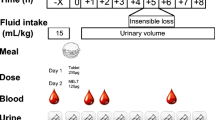Abstract
Objective
The present study was carried out to test bioequivalence between two different desmopressin nasal spray preparations. Due to the high variability of plasma pharmacokinetics of intranasally administered peptides like desmopressin, appropriate study designs are required to assess bioequivalence. Therefore, a single-dose, replicate study design was used to evaluate bioequivalence of two desmopressin nasal sprays.
Subjects and methods
Thirty-two healthy male volunteers were enrolled in the study and were randomly assigned to receive the test- and reference drug on two occasions in a 4-period 2-sequence crossover study design. Subjects received a single dose of 20 µg (10 µg per nostril) of desmopressin-acetate per study day separated by wash-out periods of at least 1 week. Desmopressin blood concentrations were measured serially over a 14-h period using a validated radioimmunoassay method. Statistical analysis was initially performed using a complicated mixed-analysis model testing for individual bioequivalence according to recommendations by the Food and Drug Administration. This approach, however, failed to converge with all defined main PK parameters and, thus, a traditional mixed analysis of variance analysis based on population averages was definitely used for testing bioequivalence between study drugs. The procedure of selecting an appropriate statistical analysis for a replicate study design was predefined in the study protocol.
Results
The 90% confidence intervals (CI) were calculated for the area under the time–concentration curve (AUC), maximum concentration (Cmax) and the time to reach Cmax (tmax) of test/reference drug ratios for a bioequivalence range from 0.80–1.25. The mean test/reference drug ratios were completely within the 90% CIs with values of 1.041 (CI: 0.892–1.216), 1.021 (CI: 0.913–1.140) and 1.068 (CI: 0.914–1.249) for AUC0–14 h, Cmax and tmax, respectively.
Conclusion
The rate and the extent of intranasal desmopressin absorption are identical for both study preparations. Thus, the desmopressin test preparation met all equivalence criteria and thereby was proven bioequivalent with a marketed reference nasal desmopressin spray.



Similar content being viewed by others
References
Andersson KE, Arner B (1972) Effects of DDAVP, a synthetic analogue of vasopressin, in patients with cranial diabetes insipidus. Acta Med Scand 192:21–27
Becker DJ, Foley TP, Jr (1978) 1-Deamino-8-d-arginine vasopressin in the treatment of central diabetes insipidus in childhood. J Pediatr 92:1011–1015
Dimson SB (1977) Desmopressin as a treatment for enuresis. Lancet 1:1260
Pedersen PS, Hejl M, Kjoller SS (1985) Desamino-d-arginine vasopressin in childhood nocturnal enuresis. J Urol 133:65–66
Mannucci PM, Ruggeri ZM, Pareti FI, Capitanio A (1977) D.D.A.V.P. in haemophilia. Lancet 2:1171–1172
Vilhardt H, Aberg M, Nilsson IM (1980) Possible use of DDAVP in coagulation disorders. In: Sutor AH, Schattauer FK (eds) DDAVP in bleeding disorders. Schattauer, Stuttgart, pp 36–41
Fjellestad-Paulsen A, Hoglund P, Lundin S, Paulsen O (1993) Pharmacokinetics of 1-deamino-8-D-arginine vasopressin after various routes of administration in healthy volunteers. Clin Endocrinol (Oxf) 38:177–182
Eller N, Kollenz CJ, Bauer P, Hitzenberger G (1998) The duration of antidiuretic response of two desmopressin nasal sprays. Int J Clin Pharmacol Ther 36:494–500
Eller N, Kollenz CJ, Hitzenberger G (1998) A comparative study of pharmacodynamics and bioavailability of 2 different desmopressin nasal sprays. Int J Clin Pharmacol Ther 36:139–145
O’Doherty DP, Bickerstaff DR, McCloskey EV, Atkins R, Hamdy NA, Kanis JA (1990) A comparison of the acute effects of subcutaneous and intranasal calcitonin. Clin Sci (Lond) 78:215–219
Fiore CE, Romagnoli A, Foti R, Coppini A (1991) Assessment of the biological activity of synthetic salmon calcitonin by intranasal administration in healthy volunteers. Drugs Exp Clin Res 17:537–542
Combe B, Cohen C, Aubin F (1997) Equivalence of nasal spray and subcutaneous formulations of salmon calcitonin. Calcif Tissue Int 61:10–15
Christians U, First MR, Benet LZ (2000) Recommendations for bioequivalence testing of cyclosporine generics revisited. Ther Drug Monit 22:330–345
Lundin S, Vilhardt H (1986) Absorption of 1-deamino-8-d-arginine vasopressin from different regions of the gastrointestinal tract in rabbits. Acta Endocrinol (Copenh) 112:457–460
Food and Drug Administration, Center for Drug Evaluation and Research, 1998b: Statistical methods for obtaining confidence intervals for individual and population bioequivalence criteria.http://www.fda.gov/cder/bioequivdata/statproc.htm
Guidance for Industry—bioavailability and bioequivalence studies for orally administered drug products—general considerations.http://www.fda.gov/cder/guidance/3615fnl.pdf, FDA/CDER (Oct 2001)
Note for guidance on the investigation of bioavailability and bioequivalence, CPMP/EWP/QWP/1401/98, EMEA (2001)
Chen ML, Lesko LJ (2001) Individual bioequivalence revisited. Clin Pharmacokinet 40:701–706
Acknowledgements
We are indebted to our study nurses Petra Zeleny and Edith Lackner for their essential contribution to the study. This work was supported by the Forschungsförderungsfonds für die Gewerbliche Wirtschaft (project no. 805253) and by a research grant from Gebro Pharma GmbH, Pharmaceutical Company, Fieberbrunn, Austria.
Author information
Authors and Affiliations
Corresponding author
Additional information
Further details on authors can be obtained at http://www.akh-wien.ac.at/klpharm
Rights and permissions
About this article
Cite this article
Joukhadar, C., Schenk, B., Kaehler, S.T. et al. A replicate study design for testing bioequivalence: a case study on two desmopressin nasal spray preparations. Eur J Clin Pharmacol 59, 631–636 (2003). https://doi.org/10.1007/s00228-003-0682-3
Received:
Accepted:
Published:
Issue Date:
DOI: https://doi.org/10.1007/s00228-003-0682-3




